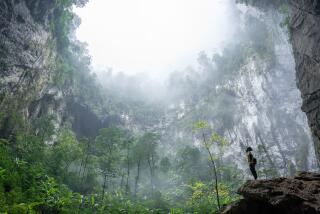In His World, the Animals Are the Players
- Share via
David Attenborough has the best job in the world. For the last 50 years, he’s traveled the globe for England’s BBC, writing and presenting such acclaimed nature television documentaries as “Life on Earth,” “The Trials of Life,” “The Life of Birds” and the appropriately titled “Attenborough in Paradise.”
Attenborough’s latest documentary, the $12-million, six-hour “Life of Mammals,” can be seen Thursday and Friday on the Discovery Channel. Attenborough has also penned a lush companion book to the series, and on May 13, BBC Video is releasing the DVD version with extra behind-the-scenes features and photo galleries.
Filmed on five continents, “Life of Mammals” explores the worlds of the 4,000 species, which have outlived the dinosaurs and managed to colonize every part of the globe. The infectiously enthusiastic 77-year-old stalks a leopard in Northern India, swims with sea otters off the coast of California and even hangs from a rope in the canopy of the forests off Venezuela to study the red howler monkey.
Thanks to state-of-the-art camera equipment, Attenborough says producing a natural history documentary is far easier today than when he started.
“Fifty years ago we couldn’t even film in the rain forest; it was too dark,” says Attenborough. “That is why all the classic national history films back in the 1950s were always [about] elephants and giraffes, because you were out on the open plain. If you wanted to do something other than the big game of East Africa, it was very difficult indeed.”
Air travel also limited the type of documentary. “The sort of program that ‘Mammals’ is and what some of the preceding series have been could not have been done before the age of jumbo jets, and that is not all that long ago,” Attenborough says.
“In the 1950s, we were very lucky indeed to get to West Africa from London. It took us three days, but the arrival of reliable jumbo jets, where you could be sure they would stick to their schedules pretty well, meant you could just decide to go to Patagonia and you could get there in half a day’s time.”
Doing one of his series is a major undertaking. In the case of “Mammals,” there were usually six camera teams in the field at any one time, so it’s fortunate for him that he’s not always required to be on location. “Often there is no need for the narrator figure to be there chatting away. I write the scripts before we start, and then different camera teams are given different jobs. Sometimes they have to go out and look for [the animals] themselves and sometimes there will be a scientist contact.”
When Attenborough does go out, a team of five -- including a cameraman, a sound recorder and a director -- usually accompanies him.
One of the sequences he’s proudest of in “Mammals” is getting a glimpse into the nest of the egg-laying platypus in Australia as she feeds her young. It is the first time this behavior has ever been witnessed by humans, let alone captured on film.
“I first tried to film that sequence 25 years ago,” says Attenborough. “At that time at the BBC we offered a bursary [scholarship] to university scientists to do a breeding program with the platypus, provided we could get access to film it if and when it nested. There wasn’t a scientist in Australia who would take it. They said it was impossible. Nobody has ever bred the thing in captivity.”
But this time around, Attenborough found a scientist in Australia who was putting radio tags on the platypus in New South Wales as a research project. “We soon realized talking to her that the radio signal would actually go through a couple of feet of earth. So if you tagged the female you could plot where the burrows ran and where it stopped and you could actually plot from that where the nesting chamber must be underground.
“We had been using for some time fiber-optic probes like they use in surgery, and if we bored very, very carefully through [the earth] we could get the probe inside the nesting chamber.
“I also had worked with a cameraman in the past, and we arranged that he and the scientist would do the preliminary preparation and start filming and I would join them at the right time.”
And was getting the chance to see a baby platypus being fed by its mother everything he hoped for?
“Absolutely!” says Attenborough with almost childlike enthusiasm.
“Life of Mammals” airs at 8 p.m. Thursday and Friday on the Discovery Channel. It is rated TV-G (suitable for all audiences).
More to Read
Sign up for The Wild
We’ll help you find the best places to hike, bike and run, as well as the perfect silent spots for meditation and yoga.
You may occasionally receive promotional content from the Los Angeles Times.







